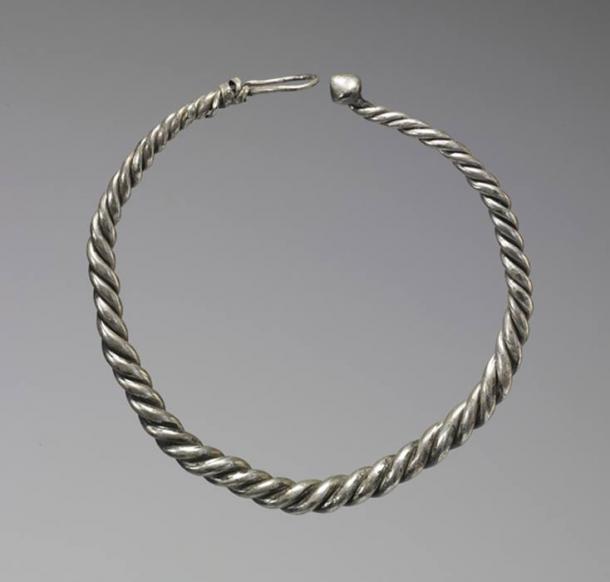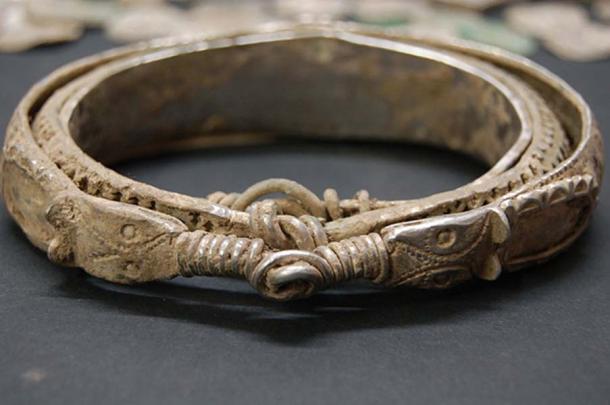
Viking-Era Jewelry: Revealing an Intricate Cultural History of the Ancient Norsemen
When you think of ancient Vikings, the first thing that pops into your mind is probably not jewelry, right? The picture that forms in the mind of most people is one of savages with long sharp spears, swords, and heavy shields attacking coastal communities. However, you will be pleased to know that Norse people of old also made beautiful and intricate jewelry in the form of bracelets, rings, necklaces, etc., out of a variety of materials including bronze, iron, gold, silver, amber, and resin. Early on in the Viking era, which is about 800 AD, these ornaments were simple, but as time went by, the pieces became more detailed and sophisticated.

Group shot of the Silverdale Hoard finds. Image by Ian Richardson. (CC BY-SA 2.0)
By occupation, Vikings were farmers and, occasionally, they were warriors. Both the men and women of the Viking community wore a wide array of jewelry, shiny objects that added some glamour to their seemingly dark world. Note, Norse ornaments had a secondary purpose, they were also used as currency in trade, which is probably the reason why the Vikings preferred using precious metals to craft their jewelry.
If an ornament was too large for the subject matter of transaction, the piece would be broken into smaller portions that would suit that particular undertaking. If you think about it, the Vikings used their jewelry like we use modern-day wallets.
However, not all Viking ornaments were metallic; the Norsemen also created beautiful ornaments using beads and precious rocks/stones. Nevertheless, it was rare for the Vikings to inset stones in their jewelry, even though this art form had been applied before the Viking Age.
Below are some interesting facts about Viking jewelry that’ll give you clearer picture of what the Nordic ornamental culture was like.
- Treasures Found Within Very Valuable Viking Hoard Finally Revealed
- Ring discovered in Viking-era grave has Arabic inscription
Necklaces/Neck-Rings
The Vikings crafted their necklaces from a variety of items including precious metals such as silver and gold, natural fiber, and iron wires of various lengths and sizes. The necklaces would normally be accompanied by pendants made from glass beads, precious stones, resin, amber (from the Baltic sea), and small metallic charms. However, the most common material for necklace pendants was glass, which would be mass produced for this purpose. The pendants on the necklaces were often souvenirs, gifts, or Nordic religious symbols that held meaning to the wearer.
The archaeological evidence of Vikings wearing necklaces is more prevalent in comparison to the evidence of neck-rings. Neck-rings that have been discovered across Europe were made of silver, bronze, or gold. Note that most neck-rings that have been discovered were in hoards and not in grave site. Therefore, there is no conclusive evidence regarding which gender wore them.
However, most historians believe that neck-rings were worn by both genders as a display of wealth and as a form of currency in commercial transactions. They were designed and crafted in standard units of weight in order to make the assessment of value more accurate. As mentioned above, a piece would be cut from the neck-ring depending on the amount necessary to conclude a commercial transaction.

This Viking neck ring is made from three twisted silver wires and is fastened by an unusual conical knob and loop clasp. It was both jewelry and money to its owner. Large neck rings and smaller arms rings were buried in Viking hoards in Ireland, Scandinavia, and England, all important hubs of Viking sea trade. This neck ring was found buried with a plain arm ring (present location unknown), in Fenit, County Kerry, Ireland in 1880. (Public Domain)
Pendants/Amulets
When it comes to Viking jewelry, the word pendant represents a broad category of items; from Mjolnir pendants, Valknut pendants, Yggdrasil pendants, and more. As much as the ancient Norsemen used a number of distinct pendants, Thor’s hammer appears to be the most frequently worn of them all. Other examples include miniature weapons such as axes and arrow heads, perforated coins, the tree of life, crosses, and the Valknut symbols . However, these amulets have been found in very few graves, suggesting that they were not commonly worn.
You may also be wondering why a pagan community would be wearing miniature crosses. Even at the height of the Viking era, Christian missionaries were adamant in converting non-believers and consequently some Norsemen adopted this new religion, forming a hybrid system of belief. Note, however, cross pendants were the rarest archeological pendant findings, which suggests that only a few Vikings accepted Christianity.
- Ten Amazing Artifacts from the Ancient World
- The long goodbye to Scandinavian Paganism and the Christianization of three realms

Left to right: Thor's hammer from Bredsättra: A 4.6 cm gold-plated silver Mjolnir pendant from Bredsättra parish, Runsten hundred, Borgholm municipality, Öland, Kalmar county, Sweden (Public Domain). Hammer pendant from Rømersdal, Bornholm (CC BY-SA 3.0). A copy of the Thor's hammer pendant from Skåne (CC BY-SA 4.0)
Beads
Viking bead ornaments were typically made of amber or glass and were some of the most common additions on necklaces. In today’s world these items are relatively cheap and widely used, but archeological evidence from Viking grave sites suggests that these ornaments were rare and not worn by many. Moreover, even the Viking ornaments with beads only had one, two, or three of them, either worn alone or with an additional pendant such as Thor’s hammer, Mjolnir. Finding more than three beads on a necklace was extremely rare, which suggests that they were precious and rare, and perhaps symbolized one’s wealth and status in society.
Additionally, seeing as archeological findings usually found only 1 to 3 beads on necklaces, it is quite possible that the number of beads a person wore represented more than just wealth and societal status. It is possible that they signified a certain level of achievement or age. A majority of beads found in archeological sites were made of glass; other materials such as jet and amber have also been discovered but are rarer to come by.

Viking Age beads. Lund University History Museum, Lund, Sweden. (mararie /CC BY SA 2.0)
Brooches
Brooches were very popular in Viking culture and were an everyday essential used for holding clothes in place. Brooches came in a number of styles with the main ones being the Penannular Brooches and Oval Brooches. The Penannular brooch was exclusively worn by Viking men and was adopted by Vikings from Scottish and Irish settlers; the trend later caught on in Russia and Scandinavia. Brooches would be fastened on the wearer’s right shoulder with the pin facing upward, which left the sword-arm free.
The oval brooch, on the other hand, was typically worn by Viking women. Oval brooches were used to fasten dresses, aprons, and cloaks and were more detailed and ornate in comparison to penannular brooches. A single brooch would be worn on the shoulder to fasten the wearer’s dress, along with a chain of colored beads for added visual appeal. Oval brooches are believed to have gone out of fashion at around 1000 AD and were replaced by more fanciful designs of brooches.
- Norsemen transformed international culture, manufacturing, tech and trade during Viking Era
- Stunning Celtic Horse Harness Became Treasured Brooch of Norwegian Viking Woman
Viking oval brooch. Museum of History, Oslo, Norway. (CC BY-SA 2.0)
Rings
Rings, like in most other cultures, were worn around the finger and were extremely popular among the Vikings. There have been numerous findings of finger rings in Viking grave sites; the rings typically had an uneven width, with most of them being open ended, possibly in order to allow them to fit on different sized fingers with minimal effort. Note, however, finger rings only became popular to the Vikings in the late ages of the Viking-era.

Bronze and iron Viking rings (replicas), close-up. (Igor Batenev /Adobe Stock)
Earrings
This was the least common form of Viking jewelry . In fact, earrings did not exist in Viking material culture until they were found in hoards amongst other types of jewelry. Nordic earrings were quite intricate and, in contrast to modern-day earrings, they would be worn over the entire ear as opposed to hanging from the earlobe. Historians have suggested that Viking earrings were of Slavic in origin and not an original concept forged by the Norsemen.
Arm Rings/Arm Bands
Arm rings/arm bands or bracelets were extremely popular in Viking culture and, like neck-rings, arm bands served a dual purpose; ornamental and commercial. Some arm rings were very intricate and detailed, having been crafted from precious metals such as gold and silver. Arm rings represented societal standing and were a display of wealth.

Nested bracelet from the Silverdale Hoard. Image by Ian Richardson. (CC BY-SA 2.0)
Arm bands came in different shapes and designs. Some were spiral in design, wrapping themselves around the arm several times, giving them a firm grip around the arm, and making it easier for the wearer to tear a piece of the end off during a commercial transaction. Other arm rings were only long enough to wrap around three-quarters of the arm; these were the bands most commonly used as currency because they were plain and flat, which made them easier to break apart whenever needed.
Viking Jewelry – Fashion with a Purpose
Vikings enjoyed fashion and the allure of precious metals and they strived to incorporate this into their day-to-day lives by crafting beautiful ornate ornaments as described above. However, unlike most cultures, jewelry pieces in Viking culture typically had a dual purpose, being used both for aesthetic appeal and as a form of currency, much like carrying money in your wallet or purse.
Evidently, Vikings were not the barbarians most people assume they were, they were an organized, sophisticated people with a rich culture that has more in common with most other cultures of their era.
Top Image: Representation of Viking jewelry. Source: Demian /Adobe Stock
References
Holmqvist, Wilhelm. Golden Age and Viking Art in Sweden: First Shown in the Museum of National Antiquities, Stockholm. Stockhom: Historiska museet, 1965. Print.
Winroth, Anders. The Age of the Vikings.2014. Print.
Grossman, Heather E, and Alicia Walker. Mechanisms of Exchange: Transmission in Medieval Art and Architecture of the Mediterranean, Ca. 1000-1500. 2013. Internet resource.
Webster, Chris. Vikings and Their Origins. Dunstable: Folens, 1993.
Wolf, Kirsten. Daily Life of the Vikings. Westport, Conn: Greenwood, 2004. Print.
Mannering, Ulla. Iconic Costumes: Scandinavian Late Iron Age Costume Iconography. 2017. Internet resource.
Jesch, Judith. Women in the Viking Age. Woodbridge: Blackwell, 1996. Print.
Wicks, Sylvia. Jewelry Making Manual. Cape Elizabeth, Me: Brynmorgen Press, 1990. Print.
Graham-Campbell, James. Silver Economy in the Viking Age. Walnut Creek, CA: Left Coast Press, 2007. Print.
















